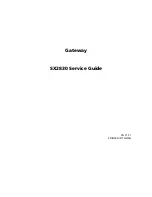
Chapter 5
Configuration Using the Web-based Utility
28
24/48-Port 10/100 + 4-Port Gigabit Smart Switch with Resilient Clustering Technology and PoE
Oversize Packets
Displays the number of oversized
packets (over 1518 octets) received on the interface since
the device was last refreshed.
Fragments
Displays the number of fragments (packets
with less than 64 octets, excluding framing bits, but
including FCS octets) received on the interface since the
device was last refreshed.
Jabbers
Displays the total number of received packets
that were longer than 1518 octets. This number excludes
frame bits, but includes FCS octets that had either a bad
Frame Check Sequence (FCS) with an integral number of
octets (FCS Error) or a bad FCS with a non-integral octet
(Alignment Error) number. The field range to detect
jabbers is between
20
ms and
150
ms.
Collisions
Displays the number of collisions received on
the interface since the device was last refreshed.
Utilization
Displays the percentage of the interface utilized.
Statistics > RMON Alarms
The
RMON Alarm
screen is used to set network alarms.
Network alarms occur when a network problem, or event,
is detected. Rising and falling thresholds generate events.
Statistics > RMON Alarm
Add Alarm
Alarm Entry
Indicates a specific alarm.
Interface
Indicates the interface for which RMON
statistics are displayed. To specify the interface, select
Unit No.
(default) and specify the unit number and port
from the drop-down menus, or select
LAG
and select the
LAG number from the drop-down menu.
Counter Name
Displays the selected MIB variable.
Sample Type
Defines the sampling method for the
selected variable and comparing the value against the
thresholds. The possible field values are:
Absolute
Compares the values directly with the
thresholds at the end of the sampling interval.
•
Delta
Subtracts the last sampled value from the
current value. The difference in the values is compared
to the threshold.
Rising Threshold
Displays the rising counter value that
triggers the rising threshold alarm. The rising threshold
is presented on top of the graph bars. Each monitored
variable is designated a color.
Rising Event
Displays the mechanism in which the alarms
are reported. The possible field values are:
LOG
Indicates there is not a saving mechanism for
either the device or in the management system. If the
device is not reset, the entry remains in the Log Table.
TRAP
Indicates that an SNMP trap is generated, and
sent via the Trap mechanism. The Trap can also be
saved using the Trap mechanism.
Both
Indicates that both the Log and Trap mechanism
are used to report alarms.
Falling Threshold
Displays the falling counter value that
triggers the falling threshold alarm. The falling threshold
is graphically presented on top of the graph bars. Each
monitored variable is designated a color.
Falling Event
Displays the mechanism in which the
alarms are reported. The possible field values are:
LOG
Indicates there is not a saving mechanism for
either the device or in the management system. If the
device is not reset, the entry remains in the Log Table.
TRAP
Indicates that a SNMP trap is generated, and
sent via the Trap mechanism. The Trap can also be
saved using the Trap mechanism.
Both
Indicates that both the Log and Trap mechanism
are used to report alarms.
Startup Alarm
Displays the trigger that activates alarm
generation. Rising is defined by crossing the threshold
from a low-value threshold to a higher-value threshold.
Interval
Defines the alarm interval time in seconds.
Owner
Displays the device or user that defined the alarm.
Click
Add to List
to add an entry to the Alarm Table.
Alarm Table
The Alarm Table lists the alarms that have been defined
using the Add Alarm section. The Alarm Table contains a
colunn for each field in the Add Alarm section, plus the
following column:
Counter Value
Displays the current counter value for the
particular alarm.
•
•
•
•
•
•
•
















































